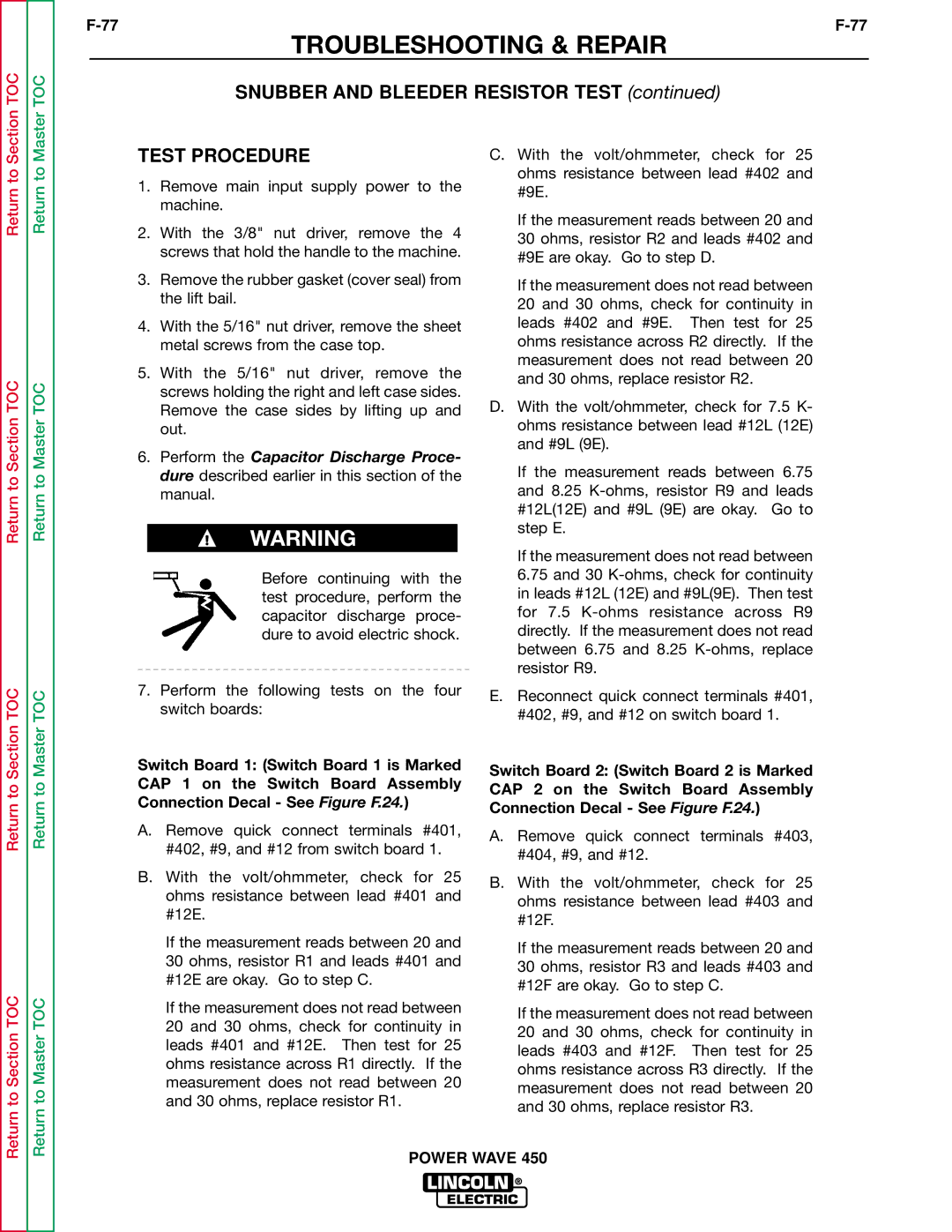
Return to
Return to Section TOC
Return to Section TOC
Return to Section TOC
Return to
Return to Master TOC
Return to Master TOC
Return to Master TOC
TEST PROCEDURE
1.Remove main input supply power to the machine.
2.With the 3/8" nut driver, remove the 4 screws that hold the handle to the machine.
3.Remove the rubber gasket (cover seal) from the lift bail.
4.With the 5/16" nut driver, remove the sheet metal screws from the case top.
5.With the 5/16" nut driver, remove the screws holding the right and left case sides. Remove the case sides by lifting up and out.
6.Perform the Capacitor Discharge Proce- dure described earlier in this section of the manual.
WARNING
Before continuing with the test procedure, perform the capacitor discharge proce- dure to avoid electric shock.
7.Perform the following tests on the four switch boards:
Switch Board 1: (Switch Board 1 is Marked CAP 1 on the Switch Board Assembly Connection Decal - See Figure F.24.)
A.Remove quick connect terminals #401, #402, #9, and #12 from switch board 1.
B.With the volt/ohmmeter, check for 25 ohms resistance between lead #401 and #12E.
If the measurement reads between 20 and 30 ohms, resistor R1 and leads #401 and #12E are okay. Go to step C.
If the measurement does not read between 20 and 30 ohms, check for continuity in leads #401 and #12E. Then test for 25 ohms resistance across R1 directly. If the measurement does not read between 20 and 30 ohms, replace resistor R1.
C. With the volt/ohmmeter, check for 25 ohms resistance between lead #402 and #9E.
If the measurement reads between 20 and 30 ohms, resistor R2 and leads #402 and #9E are okay. Go to step D.
If the measurement does not read between 20 and 30 ohms, check for continuity in leads #402 and #9E. Then test for 25 ohms resistance across R2 directly. If the measurement does not read between 20 and 30 ohms, replace resistor R2.
D.With the volt/ohmmeter, check for 7.5 K- ohms resistance between lead #12L (12E) and #9L (9E).
If the measurement reads between 6.75 and 8.25
If the measurement does not read between 6.75 and 30
E.Reconnect quick connect terminals #401, #402, #9, and #12 on switch board 1.
Switch Board 2: (Switch Board 2 is Marked CAP 2 on the Switch Board Assembly Connection Decal - See Figure F.24.)
A.Remove quick connect terminals #403, #404, #9, and #12.
B.With the volt/ohmmeter, check for 25 ohms resistance between lead #403 and #12F.
If the measurement reads between 20 and 30 ohms, resistor R3 and leads #403 and #12F are okay. Go to step C.
If the measurement does not read between 20 and 30 ohms, check for continuity in leads #403 and #12F. Then test for 25 ohms resistance across R3 directly. If the measurement does not read between 20 and 30 ohms, replace resistor R3.
